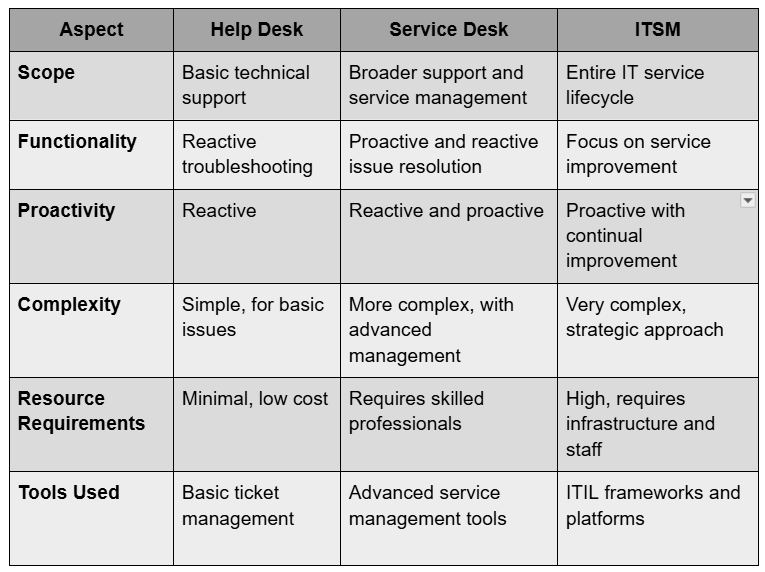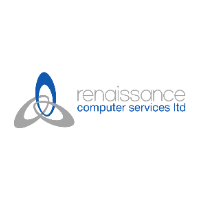Help Desk Vs. Service Desk Vs. ITSM: Key Differences Explained

In today’s rapidly evolving business environment, reliable IT support is crucial for maintaining seamless operations. Whether you're a small startup or a large corporation, ensuring your IT systems run seamlessly can make or break your company’s efficiency. Many businesses rely on different models of IT support to address issues that arise, but not all IT support functions are the same.
In this blog, we will delve into the distinctions between a Help Desk, a Service Desk, and IT Service Management (ITSM). By the end of this blog, you’ll have a clearer understanding of each role and how to choose the right option for your business needs.
What is a Help Desk?
It provides quick fixes and troubleshooting for common problems, ensuring users receive timely support for their IT concerns.
Primary Functions of a Help Desk
Technical Support: Resolving technical problems related to hardware, software, or network issues.
Service Requests: Managing requests such as password resets, system access, or software installations.
Basic Troubleshooting: Often involves resolving simple and repetitive IT issues that users may encounter on a regular basis.
Benefits of a Help Desk
Quick Response: Typically provides fast, reactive support to ensure that employees can return to work without significant disruptions.
Cost-Effective: Because the scope of service is narrow, Help Desks are less resource-intensive and often more affordable for small businesses.
Ease of Use: Simple solutions that don’t require extensive knowledge of IT infrastructure.
Limitations of a Help Desk
Limited Scope: Help Desks focus on solving straightforward issues, meaning they may not be equipped to handle complex problems or advanced service management.
Reactive Approach: A Help Desk often waits for issues to arise, which can lead to delays in resolution if proactive monitoring isn't in place.
What is a Service Desk?
A Service Desk is a more advanced form of an IT support desk offering broader service management functions. While it handles technical issues like a Help Desk, it also delivers broader service management functions. It focuses not just on resolving problems but on proactively managing requests to enhance user experience and maintain smooth IT operations.

Primary Functions of a Service Desk
Incident Management: Handling and resolving IT incidents, which are unplanned interruptions to an IT service.
Service Request Management: Managing requests from users for standard services, such as software installations, hardware upgrades, or new system access.
Change Management: Overseeing changes to IT systems and services to ensure minimal disruption and maintain service quality.
Benefits of a Service Desk
Proactive Support: Service Desks are often equipped with tools to predict and prevent potential issues, ensuring smoother operation of IT services.
Broader Service Range: They handle both incident and request management, offering a more comprehensive support experience.
Improved User Experience: The Service Desk’s ability to resolve issues quickly and provide detailed follow-up enhances overall customer satisfaction.
Limitations of a Service Desk
Resource-Intensive: Service Desks require skilled professionals and more advanced tools, which can increase costs and resource requirements.
Slower Response for Complex Issues: While Service Desks are better equipped to handle issues, more complex problems may still take time to resolve due to the necessary investigations.
What is ITSM (IT Service Management)?
IT Service Management (ITSM) is a comprehensive strategy for overseeing and delivering IT services effectively. It focuses on designing, delivering, managing, and improving the way IT is used within an organisation. ITSM is not just about reacting to problems; it’s a holistic strategy that integrates IT support with business processes to ensure that IT services align with business objectives and are continuously improved.
Core Components of ITSM
Service Strategy: Developing a strategy to ensure IT services support business goals and objectives.
Service Design: Designing IT services and processes to ensure they meet both customer needs and internal requirements.
Service Transition: The process of planning and managing the deployment of new services or service updates.
Service Operation: The day-to-day management of IT services, including monitoring and responding to incidents and requests.
Continual Service Improvement: Identifying areas for improvement in IT service delivery and implementing changes to enhance service quality.
Benefits of ITSM
Holistic Approach: ITSM provides a comprehensive framework for managing the entire IT service lifecycle.
Alignment with Business Goals: ITSM focuses on delivering IT services that align with the organisation's strategic goals, improving overall efficiency.
Continual Improvement: With a focus on improvement, ITSM ensures that IT services evolve in line with changing business needs.
Limitations of ITSM
Complexity: ITSM can be more complex and require specialised knowledge to implement effectively.
Resistance to Change: Organisations may encounter internal resistance when trying to adopt ITSM practices, slowing down implementation and reducing effectiveness.
Key Differences Between Help Desk, Service Desk, and ITSM

When to Use Help Desk, Service Desk, or ITSM?
Choosing between a Help Desk, Service Desk, or ITSM model depends on your organisation’s size, complexity, and goals. For businesses in Watford, IT support Watford can help tailor the best solution for your needs.
Help Desk
Best for small businesses with limited IT resources.
Focuses mainly on reactive support rather than proactive service improvements.
Cost-effective for companies that don’t need extensive IT service management.
Service Desk
Best for organisations with a more complex IT environment, where both incident and service request management are necessary.
Necessary for businesses aiming to improve user experience and ensure smooth day-to-day operations.
ITSM
Recommended for large enterprises that require a strategic approach to managing their IT services.
Essential for businesses that want to align IT services with broader business goals, ensuring continuous service improvement.
Useful for organisations looking to optimise their IT service delivery, with an emphasis on long-term planning and execution.

Conclusion
Selecting between a Help Desk, Service Desk, or ITSM depends on your organisation’s size and specific requirements. A Help Desk is best suited for small businesses needing fundamental IT support, whereas a Service Desk is more appropriate for medium to large businesses looking for broader, more integrated IT services. ITSM is perfect for large organisations that need a strategic approach to IT services, ensuring alignment with business goals. If you’re looking to optimise your IT services, consider expert guidance.
At Renaissance Computer Services Limited, we provide IT support services tailored to your needs, from essential IT assistance to comprehensive ITSM solutions, enhancing your business efficiency.


